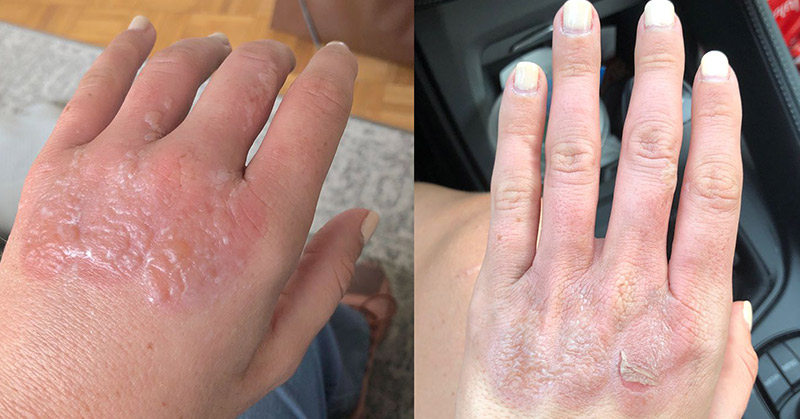Nothing celebrates summer more than a day at the pool with freshly blended margaritas. That’s what Courtney Fallon and her family planned for the Memorial Day weekend, oblivious to the painful condition Courtney was about to receive.
The family spent the first day of their vacation relaxing by the pool. Courtney volunteered to mix everyone’s favorite summer drink of ice-cold margaritas. While the hot Floridian sun shone, Courtney squeezed what she considered “hundreds of limes,” blended with ice, added tequila, and poured the drinks for everyone to enjoy.
After a perfect first day of vacation, Courtney woke up the next morning, ready to hit the pool again, when a sharp pain flared through her hands as if they were on fire. To her chagrin, the area around her knuckles was covered in swollen, red blisters.
It was not a simple sunburn.
Courtney suffered from a skin condition researchers have nicknamed the “margarita burn,” medically known as phytophotodermatitis.
What is Phytophotodermatitis?
The name can be broken down into three parts:
- Phyto, comes from the Greek word for “plant.”
- Photo, which comes from the Greek word for light, in this case the sun.
- Dermatitis, which means skin inflammation
Altogether, phytophotodermatitis occurs when certain plant chemicals cause skin inflammation when exposed to sunlight. These chemicals increase the skin’s photosensitivity, or how sensitive we are to UV radiation from the sun. This condition is unsurprisingly most common in the summer when people spend more time outside.
These plant chemicals contain compounds called furocoumarins, and when they are exposed to ultraviolet light on a person’s skin, it causes a photochemical reaction that damages and even kills skin cells. Reactions vary depending on the person, but the results are usually large blisters, a burning sensation, redness, swelling, and sharp pain.
Furocoumarins are present in:
- Citrus fruits, commonly limes and lemons
- Carrots
- Wild parsnip
- Parsley
- Celery
- Dill
- Figs
Therefore, bartending in direct sunlight can put someone, like Courtney, at risk for this condition. Additionally, the trend of using lemon juice as a natural hair bleach by rubbing it through one’s hair and sitting in the sun, can also be a risk if the lemon juice trickles onto the person’s exposed scalp or face. [1]
How to Identify Phytophotodermatitis
This skin condition can be distinguished by its irregular-shaped blisters that manifest a few hours after sun exposure. Sometimes it is misdiagnosed as severe sunburns, chemical burns, atopic dermatitis, or cellulitis. However, phytophotodermatitis has a distinct reaction.
“It only develops in areas where the chemical touches the skin, explaining odd shapes like streaks or dots where lime juice may have dripped down the skin or splashed,” says Dr. Joshua Zeichner, MD, the director of cosmetic and clinical research at Mount Sinai Hospital in New York City.
“The initial rash is fiery red and it often heels with a dark brown-black.” [2]
How to Treat Phytophotodermatitis
Fortunately, there are multiple ways to deal with the pain and discomfort involved with this burn. If someone suspects they have this condition, it’s best to see their doctor for a proper diagnosis. This is what a patient might expect:
- For mild cases, use a cold compress and/or natural cream containing colloidal oatmeal. Over-the-counter medications like ibuprofen and aspirin may be recommended as well to help relieve the pain and inflammation.
- For moderate blisters, topical steroid creams may help reduce the itching and inflammation.
- For severe burns, the patient may be prescribed oral corticosteroids or antihistamines.
After about one to two weeks, the initial symptoms of pain, blisters, swelling, and itchiness should subside on their own.
The patient may develop patches of red, crusted skin. It’s imperative not to pick or peel at these patches—it will prolong the healing and cause scarring. A doctor can prescribe emollient-based creams to hydrate and protect the sensitive skin.
Needless to say, it’s crucial to shade the infected skin from sunlight, which may cause further burns.
Fortunately, phytophotodermatitis is not a recurring issue. It can heal completely with time and proper care.
“It only rarely causes any permanent changes to the skin,” Dr. Zeichner says. [3]
How to Prevent Phytophotodermatitis
This skin condition is easy to avoid once a person understands what causes it.
“If you come in contact with a plant or food known to cause phytophotodermatitis, [such as citrus fruits, celery, parsely, etc.] make sure to protect the skin with clothing or gloves and wash the skin thoroughly before going into the sun,” says Dr. Zeichner.
Plastic gloves used for food preparation or gardening are smart ways to avoid the issue for people juicing lemons for lemonade, picking parsley, or squeezing limes for margaritas.
Gloves are also useful for other activities that can lead to phytophotodermatitis, such as:
- Cooking and bartending
- Building campfires with furocoumarin-containing wood
- Handling plants with a lot of sap
- Gardening
- Touching plants when UV levels are high
Overall, keep hands clean of furocoumarins and rubbed with natural non-nano mineral sunblock for a burn-free summer. [4]
- Lime-induced phytophotodermatitis https://www.ncbi.nlm.nih.gov/pmc/articles/PMC4185147/
- Phytophotodermatitis https://www.dermnetnz.org/topics/phytophotodermatitis/
- Phytophotodermatitis: The Other “Lime” Disease https://www.annemergmed.com/article/S0196-0644(16)00127-X/fulltext
- Sun-related Skin Condition Triggered by Chemicals in Certain Plants, Fruits https://newsnetwork.mayoclinic.org/discussion/sun-related-skin-condition-triggered-by-chemicals-in-certain-plants-fruits/

